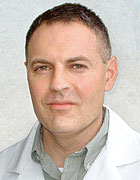The biomechanical and histologic effects of platelet-rich plasma on rat rotator cuff repairs. Journal Article
Local Library Link: Find It @ Loyola
| Authors: | Beck, J.; Evans, D; Tonino, P. M.; Yong, S.; Callaci, J. J. |
| Article Title: | The biomechanical and histologic effects of platelet-rich plasma on rat rotator cuff repairs. |
| Abstract: | BACKGROUND: Rotator cuff tears are common injuries that are often treated with surgical repair. Because of the high concentration of growth factors within platelets, platelet-rich plasma (PRP) has the potential to enhance healing in rotator cuff repairs. HYPOTHESIS: Platelet-rich plasma would alter the biomechanical and histologic properties of rotator cuff repair during an acute injury response. STUDY DESIGN: Controlled laboratory study. METHODS: Platelet-rich plasma was produced from inbred donor rats. A tendon-from-bone supraspinatus tear was created surgically and an immediate transosseous repair performed. The control group underwent repair only. The PRP group underwent a repair with PRP augmentation. Rats in each group were sacrificed at 7, 14, and 21 days. The surgically repaired tendons underwent biomechanical testing, including failure load, stiffness, failure strain, and stress relaxation characteristics. Histological analysis evaluated the cellular characteristics of the repair tissue. RESULTS: At 7- and 21-day periods, augmentation with PRP showed statistically significant effects on the biomechanical properties of the repaired rat supraspinatus tear, but failure load was not increased at the 7-, 14-, or 21-day periods (P = .688, .209, and .477, respectively). The control group had significantly higher stiffness at 21 days (P = .006). The control group had higher failure strain at 7 days (P = .02), whereas the PRP group had higher failure strain at 21 days (P = .008). Histologically, the PRP group showed increased fibroblastic response and vascular proliferation at each time point. At 21 days, the collagen fibers in the PRP group were oriented in a more linear fashion toward the tendon footprint. CONCLUSION: In this controlled, rat model study, PRP altered the tissue properties of the supraspinatus tendon without affecting the construct's failure load. CLINICAL RELEVANCE: The decreased tendon tissue stiffness acutely and failure to enhance tendon-to-bone healing of repairs should be considered before augmenting rotator cuff repairs with PRP. Further studies will be necessary to determine the role of PRP in clinical practice. |
| Journal Title: | American Journal of Sports Medicine |
| Volume: | 40 |
| Issue: | 9 |
| ISSN: | 0363-5465 |
| Publisher: | Unknown |
| Journal Place: | United States |
| Date Published: | 2012 |
| Start Page: | 2037 |
| End Page: | 2044 |
| Language: | English |
| DOI/URL: |
|
| Notes: | ID: 12644; Status: MEDLINE; Publishing Model: Journal available in: Print-Electronic Citation processed from: Internet; NLM Journal Code: 7609541, 3yr |



